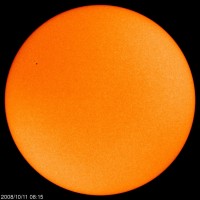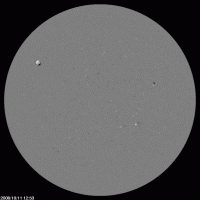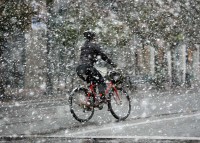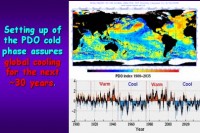
|
Oct 12, 2008
The Climate Change Unbelievers
By Tim Walker, UK Independent
Global warming is happening and we’re to blame, right? That’s certainly the view of almost every expert in the field. But a die-hard band of naysayers continues to rail against the consensus. Are they completely mad? Judge for yourself.
Not everybody likes Gore and his beliefs about the future of our planet and especially not Hans Schreuder, the 62-year-old former chemist who runs the Gore-baiting website Ilovemycarbondioxide.com. Schreuder is one of the climate-change sceptics who continue to make their case despite the mounting evidence of climate change that we, the public, are presented with every day; despite the unanimous endorsement of climate-change theory by every national academy of science in the industrialised world.
The sceptics declare that the central evidence for carbon-driven climate change in the reports of the IPCC are nonsense. Specifically, the “hockey stick” graph, which correlates the steep rise in world temperatures to the steep rise in carbon emissions, and which Gore demonstrates, with the help of a hydraulic crane, in his film An Inconvenient Truth. Gore’s opponents say there’s evidence that world temperatures have, in fact, begun to fall since 2000.
In 2005, the House of Lords Economics Committee voiced “concerns” about the objectivity of the IPCC, suggesting some of the agency’s emissions projections were “influenced by political considerations”. The committee’s claims were subsequently rejected by the Government and the Stern Review on the economics of climate change, but the vested-interests argument unites sceptics, and mirrors the accusations often levelled at them in turn, that they are in the pockets of big oil, big gas, or the US Republican Party.
The sceptics come from the worlds of politics, economics, television and, crucially, science. David Bellamy, a professor of botany who was formerly the televisual face of eco-evangelism, has been compared with a Holocaust denier because he doesn’t believe carbon emissions cause climate change. Climatologist Piers Corbyn is convinced climate change is caused by solar activity, not CO2. Economist Ruth Lea warns of the IPCC’s political and business interests. Martin Durkin, maker of the documentary The Great Global Warming Swindle, says the green industry is in too deep to afford to acknowledge scientific law. And the former Chancellor, Nigel Lawson, maintains that though the science of climate change could be broadly correct, its consequences have been exaggerated. Read more here.
This story implies the skeptic voices are few and far between. See how EPW has over listed 500 scientists who have taken positions against the so called consensus here, see the Petition Project with over 31,000 signatures and 9,100 PhD.s arguing there is no convincing scientific evidence that man is causing catastrophic effects on the earth’s climate here, and the Manhattan Declaration from the first International Climate Change Conference stating “Global warming” is not a global crisis here.
Oct 12, 2008
Significant Cycle 24 Sunspot Group Emerges
By Anthony Watts, Watts Up With That
This is the biggest Cycle 24 spot since the first one was seen on January 4th, 2008. This spot looks to have some staying power other than the “specks” we’ve seen winking on and off lately. No squinting to see this one, or wondering if it’s a dead pixel in the SOHO CCD imager or not.

See larger image here
The corresponding magnetogram image, seen here, is also quite pronounced.

The polarity is correct, with the white “North” at the top. This spot grew quickly as it came around the rim into visibility. Watch this animation here.
At the same time, to the right of the image, at lower latitude, a new cycle 23 sunspot seems to be emerging, note it has a reveresed polarity from the larger SC24 spot. Solar cycle 23 just won’t give up it seems.
The magentic field, as shown by the Average Planetary index (Ap) remained low in September, see here.
Oct 11, 2008
Record Early Snow Hitting Northern Rockies
By Zack Benoit, Billings Gazette
An early-winter storm kicked into high gear Friday, blanketing much of southern Montana and northern Wyoming with snow. Wet, heavy snow fell throughout the day in Billings. The storm is expected to continue at least through Sunday and bring as much as 20 inches of snow to the Billings area. A snowfall record for Oct. 11 was set in Billings yesterday. According the National Weather Service, Billings saw 3.1 inches of snow Friday. The old record of 2.8 inches was set in 1969. See video story here.
By 9 a.m. today, many towns in the region were reporting heavy snowfall. Park City and Colstrip each received 5 inches, Red Lodge reported 18 inches and Nye had 19. As of 3pm MDT Saturday, Cole Creek reported 34 inches. Areas in Eastern Montana have not received much snow, but it has been raining - Miles City reported about 0.5 inches this morning - but snow is expected to begin falling there this evening. Read more here.
Meanwhile to the west in Idaho according to the Idaho Stateman story, Boise had the earliest snow on record. Big snow flakes fell early Friday evening, turning Downtown Boise into a giant snow bowl for people on their way home from work. The snow caught many people off guard, including this bicyclist heading down Idaho Street between 8th and 9th around 5:45 p.m.

Across the Treasure Valley, tree branches heavy with wet, snow-covered leaves fell on power lines, causing scattered power outages.
This is the earliest measurable snowfall in Boise since record keeping began in 1898, according to the National Weather Service. At 10 p.m., the Weather Service said 1.7 inches of snow had fallen. The previous earliest recorded snowfall was Oct. 12, 1969, when a little more than an inch fell. And if the snow wasn’t enough, meteorologists say winds across southwestern Idaho will average 25 to 40 mph through Saturday afternoon, with gusts up to 55 mph. Sustained winds of 30 to 40 mph are expected, which can make driving difficult.
Oct 08, 2008
Implications of PDO and NAO Shifts and Global Climate in Upcoming Decades
By Dr. Don Easterbrook
In a Geological Society of America abstract, Dr. Don Easterbrook, Professor of Geology at Western Washington University, presents data showing that the global warming cycle from 1977 to 1998 is now over and we have entered into a new global cooling period that should last for the next three decades. He also suggests that since the IPCC climate models are now so far off from what is actually happening that their projections for both this decade and century must be considered highly unreliable.
The Pacific Ocean has a warm temperature mode and a cool temperature mode and in the past century has switched back forth between these two modes every 25-30 years (known as the Pacific Decadal Oscillation or PDO). In 1977 the Pacific abruptly shifted from its cool mode (where it had been since about 1945) into its warm mode, and this initiated global warming from 1977 to 1998. The correlation between the PDO and global climate is well established. The announcement by NASA’s Jet Propulsion Laboratory that the Pacific Decadal Oscillation (PDO) had shifted to its cool phase is right on schedule as predicted by past climate and PDO changes (Easterbrook, 2001, 2006, 2007). The PDO typically lasts 25-30 years and assures North America of cool, wetter climates during its cool phases and warmer, drier climates during its warm phases. The establishment of the cool PDO, together with similar cooling of the North Atlantic Oscillation (NAO), virtually assures several decades of global cooling and the end of the past 30-year warm phase. It also means that the IPCC predictions of catastrophic global warming this century were highly inaccurate.

See larger image here
As shown by the historic pattern of PDOs over the past century and by corresponding global warming and cooling, the pattern is part of ongoing warm/cool cycles that last 25-30 years. The global cooling phase from 1880 to 1910, characterized by advance of glaciers worldwide, was followed by a shift to the warm-phase PDO for 30 years, global warming and rapid glacier recession. The cool-phase PDO returned in ~1945 accompanied by global cooling and glacial advance for 30 years. Shift to the warm-phase PDO in 1977 initiated global warming and recession of glaciers that persisted until 1998. Recent establishment of the PDO cool phase appeared right on target and assuming that its effect will be similar to past history, global climates can be expected to cool over the next 25-30 years. The IPCC prediction of global temperatures 1 F warmer by 2011 and 2 F by 2038 stand little chance of being correct.
The global warming of this century is exactly in phase with the normal climatic pattern of cyclic warming and cooling and we have now switched from a warm phase to a cool phase right at the predicted time (see graph below).

See larger image here
See full post here.
Oct 05, 2008
Peru Studies Climate Riddle
By Terry Wade, Reuters
Scientists are using everything from a yellow submarine to weather balloons and special airplanes to solve a climate conundrum: why is Peru getting colder while the rest of the world heats up? Researchers from Europe, the United States and South America started collecting reams of data this week from clouds, the shoreline and deep underwater to try to figure out the dynamics of the southeastern Pacific. The area, home to a fifth of the world’s fish stocks, plays a crucial part in global weather patterns and scientists want to discover why temperatures have dropped on the desert coast.
“Peru has a very important role in global climate,” said Alexis Chaigneau, a French scientist leading experiments in Peru. “Over the past 50 years, the Peruvian coast has gotten colder, mainly because of stronger winds that have pulled up the deep cold waters of the ocean current.” The Humboldt current, which flows north to Peru from the frigid southern waters off Chile, is considered the world’s most productive marine ecosystem, in part because deep cold waters rich in nutrients interact with the sun’s energy to create life.
For the next three months, everything from a small satellite-controlled submarine to cloud-hugging airplanes will feed computers with information on oxygen levels in the water, temperature, salinity, wind speeds and current. Along the way, they also hope to solve the riddles of the famous El Nino and La Nina weather phenomenon that occur in the southeastern Pacific—the periodic oscillations in surface water temperatures that are linked to floods and droughts. Read more here.
Icecap Notes: A few things should be noted. Some of the world’s warming (most peer-reviewed studies suggest 50%) in the last half of the 20th century was due to urbanization and land use changes not properly accounted for by the national centers. Of course neither population nor land use is an issue in the waters off Peru. As the late John Daly showed here, most non-urban stations, island locations may have shown cyclical but no net changes long term.
Secondly the PDO cycle which went from cold 50 years ago to warm from 1979 to 1998 then cold again should produce no net change over 50 years but a net cooling over 30 years. Here is a plot of temperatures from the eastern most NINO regions (NINO12) - annual mean surface ocean temperatures fron 0 to 10 degrees south and between 80 and 90 degrees west. You see a no net change since 1950 but a warming from the first few decades to the 1980s and 1990s as in the Warm PDO, more El Ninos occurred and then a slight cooling recently with a return to a cold PDO.

See larger image here.
The TAO Triton buoy network established in 1984 after the super El Nino of 1982/83 provides a lot of valuable information about surface and depth water temperature patterns. Additional data analyses and plots are available here.
|
|
|
|








